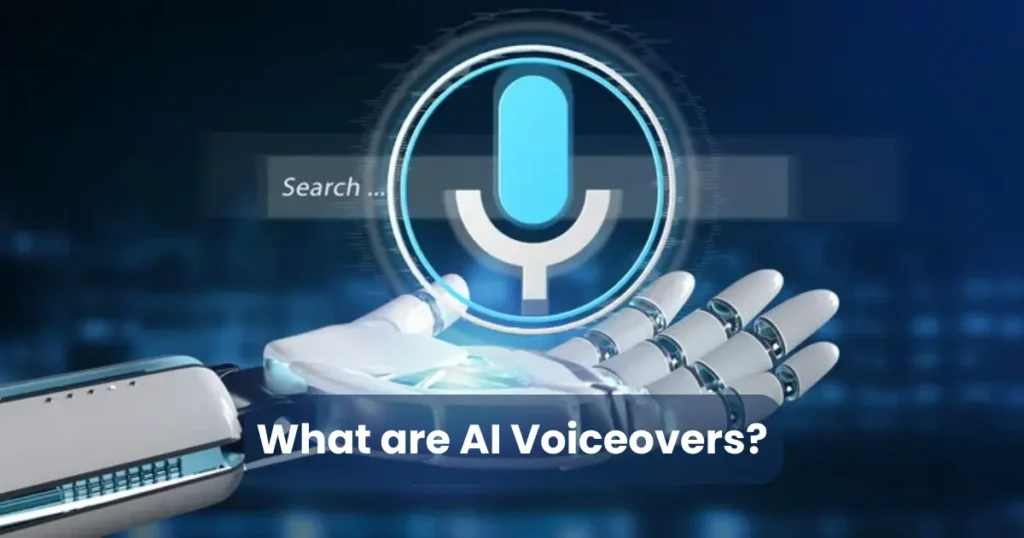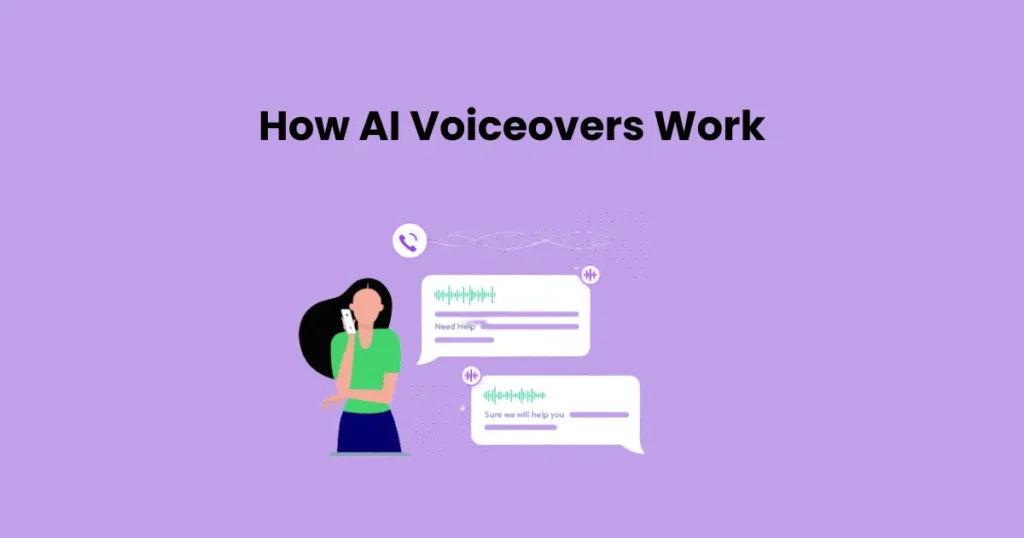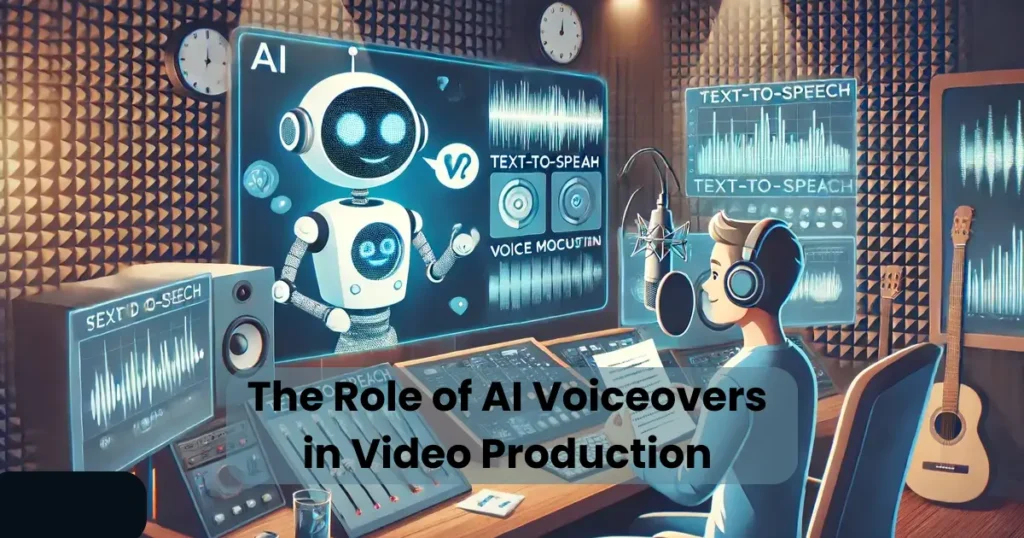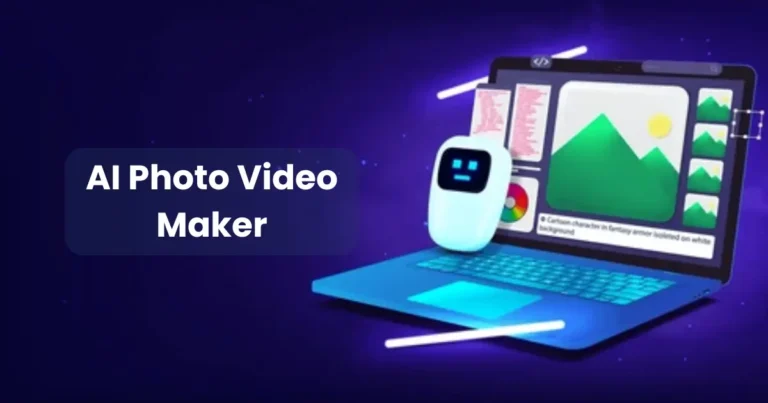The Technology Behind AI Voiceovers in Video

Contents
- 1 What are AI Voiceovers?
- 2 How AI Voiceovers Work
- 3 The Advantages of AI Voiceovers
- 4 The Role of AI Voiceovers in Video Production
- 4.1 Streamlining the Video Creation Process
- 4.2 Cost-Effective Voiceover Solutions for Large Projects
- 4.3 Enhancing Accessibility in Video Content
- 4.4 Personalization of Content
- 4.5 Supporting Different Video Formats and Platforms
- 4.6 Facilitating Voiceovers for Animations and Virtual Environments
- 4.7 Enabling Real-Time Voiceover Adjustments
- 5 The Future of AI Voiceovers
- 5.1 Increased Realism and Naturalness
- 5.2 Emotionally Intelligent AI Voiceovers
- 5.3 Multilingual and Multicultural Capabilities
- 5.4 AI Voiceover Personalization at Scale
- 5.5 Interactive and Dynamic Voiceovers
- 5.6 Integration with Other AI Technologies
- 5.7 Ethical Considerations and Regulation
- 5.8 Conclusion
The technology behind AI voiceovers in video has become a game-changer in the world of multimedia production.AI advancements now let voiceover systems create lifelike voice recordings from text. This offers video producers a fast, cost-effective solution. The technology is transforming industries like entertainment, advertising, and education. It enables quick, scalable voiceovers without losing quality. As it evolves, AI voiceover tech could revolutionize video production, making it more accessible and customizable for creators worldwide.
What are AI Voiceovers?
Artificial intelligence (AI) systems generate synthetic voice recordings, known as AI voiceovers, to mimic human speech.. These systems use advanced algorithms and machine learning models to convert written text into spoken words in various voices. Unlike traditional voiceovers that rely on human actors, AI systems use TTS technology, deep learning, and neural networks to generate voiceovers.

Developers train AI systems on vast amounts of recorded speech, allowing them to replicate the nuances of human vocal patterns. As a result, AI voiceovers sound highly natural, with precise pronunciation, tone, and pacing. This adaptable technology enables content creators to generate various voices, accents, and languages for diverse applications.
Video producers use AI voiceovers for fast, scalable projects like explainer videos, e-learning, and automated customer service.
How AI Voiceovers Work
AI voiceovers are the result of several advanced technologies working together to convert written text into spoken words. The process involves machine learning, neural networks, and speech synthesis techniques to create voices that sound realistic and lifelike. Here’s a breakdown of how AI voiceovers work:

Neural Networks and Deep Learning
Neural networks lie at the core of AI voiceover technology, mimicking how the human brain processes information. Training on large audio and text datasets helps AI learn subtle speech patterns and sound more natural over time.
Engineers use deep learning models to refine neural networks, enabling the AI to recognize speech features like emotion, emphasis, and rhythm—key to high-quality voiceovers. With repeated training, the AI learns to synthesize speech that closely resembles human tones and nuances.
Text-to-Speech (TTS) Technology
Text-to-Speech (TTS) technology primarily converts written text into audio. The system breaks text into phonemes the smallest sound units and converts them into speech. TTS engines use algorithms to determine pronunciation, stress, and pacing. The result is a voiceover that sounds fluid and coherent.
Modern TTS systems handle more than just basic speech synthesis. They take into account factors like punctuation, sentence structure, and the intended meaning of the text, ensuring that the AI-generated voiceover sounds natural and contextually accurate. Some TTS engines support real-time speech, enabling on-demand voiceovers for various applications.
Voice Cloning and Customization
Voice cloning is another critical aspect of AI voiceovers. This technology enables AI systems to recreate specific voices by analyzing audio recordings of a person’s voice. After training the AI on a large dataset of a particular voice, developers can generate voiceovers that sound almost identical to the original speaker. This has significant implications for industries that require branded voices or highly personalized content.
Voice customization goes a step further, allowing creators to modify the AI’s voice to suit their needs. Users can adjust the pitch, speed, and tone of the generated voice to create unique sound profiles. This level of customization makes AI voiceovers adaptable to a wide range of projects, from professional corporate videos to entertaining advertisements.
In summary, AI voiceovers work by leveraging deep learning and neural networks to produce lifelike speech from text. Using TTS technology and voice cloning, AI generates high-quality, customizable voiceovers that sound natural and work across various media formats. This advanced technology has transformed voiceover production, making it more accessible, efficient, and cost-effective.
The Advantages of AI Voiceovers
AI voiceovers offer numerous benefits, revolutionizing how audio is produced across various industries. From cost efficiency to enhanced customization, AI-generated voices are quickly becoming a staple in video production, marketing, and interactive media. Below are the key advantages of using AI voiceovers:

Cost-Effectiveness
One of the most significant benefits of AI voiceovers is the reduction in costs. Traditional voiceover production typically involves hiring professional voice actors, renting studio space, and coordinating multiple recording sessions. This process can be expensive, especially for large-scale projects. AI voiceovers, on the other hand, eliminate these costs. Once developers train the AI system and prepare the script, they can generate voiceovers at a fraction of the price. This benefits budget-conscious businesses or those producing high volumes of ads, explainer videos, or e-learning content.
Efficiency and Speed
AI voiceovers are produced at remarkable speed compared to traditional voiceover work. Once the text is prepared, the AI generates the voiceover almost instantly, enabling rapid turnaround times. This is especially beneficial for projects with tight deadlines, such as marketing campaigns or time-sensitive video content. AI systems generate voiceovers 24/7, boosting efficiency and allowing quick script changes.
Consistency
AI voiceovers offer unmatched consistency. Unlike human voice actors, AI maintains consistent tone, pace, and clarity throughout a project. This is key for long-form content like audiobooks or training materials. AI ensures that the voice remains clear and steady, regardless of the length or complexity of the content.
Scalability
AI voiceovers enable scalability in content production. Whether you’re producing a single video or a series of videos, AI can easily handle large volumes of voiceover work. This scalability is essential for companies producing content in multiple languages, regions, or for varied media platforms. Instead of hiring multiple voice actors for each project or language, AI systems can generate consistent voiceovers across different scripts and languages in no time.
Customization and Flexibility
AI voiceovers can be highly customizable, allowing creators to choose from a range of voices, accents, and tones. Whether you need a formal, friendly, or energetic voice, AI systems can tailor the voiceover to match the desired style. Voice cloning replicates specific voices, helping maintain brand consistency across projects. Developers can adjust style or tone on demand without new recordings.
Multilingual Capabilities
AI voiceover technology has made it easier to reach a global audience. AI enables multilingual dubbing without hiring separate voice actors. This helps businesses reach new markets and broader audiences while keeping a consistent voice across regions.
In conclusion, AI voiceovers provide significant advantages in terms of cost, speed, consistency, scalability, and customization. These advantages make AI voiceovers essential for creators needing high-quality, flexible, and efficient audio. As the tech improves, its use in video, marketing, and more will keep growing.
The Role of AI Voiceovers in Video Production
AI voiceovers have become an integral part of video production, transforming the way content creators produce and enhance their videos. From speeding up production timelines to offering high-quality audio solutions, AI voiceovers play a crucial role in many aspects of modern video production. Below are several key ways AI voiceovers are reshaping the video industry:

Streamlining the Video Creation Process
In traditional video production, the process of adding voiceovers involves coordinating with voice actors, scheduling recording sessions, and sometimes multiple rounds of edits. AI voiceovers simplify this process by enabling creators to generate voiceovers in minutes. Once the script is finalized, the AI system can produce the voiceover almost instantly, allowing for a more streamlined workflow. This is especially valuable for projects that require rapid turnaround times, such as social media videos or last-minute marketing content.
Cost-Effective Voiceover Solutions for Large Projects
Producing high-quality voiceovers for large-scale video projects can be expensive, especially when many different voice actors are needed. AI voiceovers offer a cost-effective solution, allowing production teams to generate professional-grade voiceovers at a fraction of the price. This is particularly advantageous for projects that require voiceovers in multiple languages or on a larger scale, such as corporate training videos, explainer videos, or e-learning content.
Enhancing Accessibility in Video Content
AI voiceovers also play a significant role in making video content more accessible. For multilingual videos, AI can quickly generate voiceovers to reach a global audience. Paired with subtitles, it also improves accessibility for viewers with hearing impairments.
Personalization of Content
AI voiceovers offer the ability to personalize content in ways that were previously not possible. Voice customization lets creators adjust pitch, speed, tone, and accent to match the video’s style. Whether friendly or authoritative, AI offers flexible personalization without repeated recordings or rehiring voice actors.
Supporting Different Video Formats and Platforms
Different video formats and platforms may require varying voiceover styles, and AI voiceovers can easily adapt to these needs. AI-generated voices can match the tone of any content—social clips, documentaries, or animations. Multilingual and accented voiceovers help tailor videos to specific audiences.
Facilitating Voiceovers for Animations and Virtual Environments
AI voiceovers are particularly beneficial for animation and virtual environments, where voiceovers are often needed to bring characters or virtual beings to life. In these scenarios, AI can generate distinct voices for different characters, giving animators more flexibility in creating diverse personalities. Additionally, in virtual environments, AI can be used to create dynamic, context-sensitive voiceovers that change based on user interaction, enhancing the overall immersive experience.
Enabling Real-Time Voiceover Adjustments
AI voiceover technology allows for real-time adjustments during video production. If changes need to be made to the script, the voiceover can be updated instantly without requiring a new recording session. This is particularly useful in fast-paced production environments where last-minute script changes are common. The ability to generate voiceovers quickly and make adjustments on the fly ensures that videos remain timely and aligned with the evolving vision of the project.
In conclusion, AI voiceovers play a pivotal role in modern video production by enhancing efficiency, reducing costs, and enabling high levels of customization. From improving accessibility to supporting large-scale projects, AI voiceover technology has become an indispensable tool for video creators. As this technology continues to advance, its applications in video production will only expand, offering new opportunities for content creators to innovate and engage their audiences.
The Future of AI Voiceovers
The future of AI voiceovers is poised for remarkable advancements, with rapid technological developments promising even more sophisticated and realistic applications. As AI continues to evolve, so too does its potential to transform how voiceovers are created, delivered, and integrated into various forms of media. Here are several key trends and possibilities for the future of AI voiceovers:

Increased Realism and Naturalness
While AI voiceovers have already achieved impressive levels of realism, future developments will focus on making the generated voices sound even more lifelike. Advances in deep learning and neural networks will continue to refine AI’s ability to capture subtle nuances in speech, such as emotion, inflection, and tone. As a result, AI-generated voices will become indistinguishable from those of human voice actors, enabling a more natural and human-like auditory experience for viewers. This progress will expand the range of AI voiceover applications, from entertainment to customer service and beyond.
Emotionally Intelligent AI Voiceovers
One of the most exciting directions for AI voiceovers is the integration of emotional intelligence. In the near future, AI systems will not only replicate neutral speech patterns but will also be able to detect and express emotions based on context. For instance, AI could modulate its tone to convey excitement, sadness, urgency, or empathy, depending on the content and purpose of the voiceover. This would allow for more emotionally engaging content, which is essential in fields such as film, gaming, and interactive media, where tone and mood significantly impact the audience’s experience.
Multilingual and Multicultural Capabilities
As globalization continues, the demand for content in multiple languages is growing. AI voiceover technology will increasingly support a wider variety of languages, dialects, and accents, making it easier for creators to produce content that resonates with diverse audiences. In addition, the ability to localize content with culturally appropriate nuances will become more refined. This could include adjusting not only the language but also cultural references, idioms, and expressions to ensure that voiceovers feel authentic and relatable to specific regions or markets.
AI Voiceover Personalization at Scale
Personalization is already a key feature of AI voiceovers, but in the future, it will reach new heights. Users will be able to create custom voices that reflect specific personalities, preferences, or brand identities. This will allow companies and creators to develop unique voice profiles tailored to their needs. For example, a brand could create a voice that embodies its core values and consistently use it across different platforms and mediums. Additionally, AI could adapt to the viewer or listener’s preferences in real-time, adjusting speech styles based on previous interactions or demographic data.
Interactive and Dynamic Voiceovers
The future of AI voiceovers will likely involve more interactivity and dynamic adaptation. In virtual reality (VR), augmented reality (AR), and gaming environments, AI-generated voices could change in real-time based on user interactions. For example, in a video game, the character’s voice could change depending on the player’s actions or decisions, making the experience more immersive and responsive. Similarly, in virtual assistants and AI-driven chatbots, voiceovers could be dynamically adjusted to reflect the conversation’s flow, offering a more fluid and human-like interaction.
Integration with Other AI Technologies
AI voiceovers will also become more integrated with other AI-driven technologies. For instance, AI could work seamlessly with video editing and visual content creation tools to synchronize voiceovers with animations, video clips, or graphics in real-time. This level of integration could allow creators to produce entire multimedia projects with minimal human intervention, accelerating production timelines and reducing the need for manual editing. Furthermore, AI voiceovers could be used in conjunction with sentiment analysis, content recommendation systems, and personalization algorithms to create highly tailored and targeted content for specific audiences.
Ethical Considerations and Regulation
As AI voiceover technology advances, ethical concerns and regulatory measures will become increasingly important. With the ability to clone voices and create highly realistic audio, issues related to consent, voice theft, and misinformation will need to be addressed. Future developments may include mechanisms to verify the authenticity of AI-generated voiceovers and ensure that they are used responsibly and transparently. Governments and industry bodies will likely introduce regulations to prevent misuse of voice cloning and ensure the ethical application of AI voiceover technology.
In conclusion, the future of AI voiceovers holds tremendous potential, with advancements in realism, emotional intelligence, personalization, and interactivity. As this technology continues to evolve, it will become an even more integral part of video production, marketing, gaming, and many other industries. While the possibilities are exciting, it is equally important to consider the ethical implications and ensure that AI voiceovers are used responsibly as they become more advanced and widely adopted.
Conclusion
AI voiceovers are revolutionizing the world of video production and content creation by offering an efficient, cost-effective, and highly customizable alternative to traditional voiceover methods. As the technology continues to improve, AI-generated voices are becoming more natural, expressive, and adaptable, allowing creators to deliver high-quality audio solutions that meet a wide range of needs. From enhancing the accessibility of content to supporting personalized and interactive experiences, AI voiceovers are quickly becoming an indispensable tool across industries.
Looking ahead, the future of AI voiceovers is filled with exciting possibilities, including more lifelike and emotionally intelligent voices, multilingual capabilities, and seamless integration with other AI technologies. However, as the technology advances, it will be essential to address ethical considerations and ensure that AI-generated voices are used responsibly and transparently.
Ultimately, AI voiceovers are shaping the future of video production by making it easier, faster, and more accessible for creators to produce high-quality content at scale. As AI continues to evolve, it will undoubtedly play an even more pivotal role in how we engage with and experience video and audio content in the years to come.






